- Review Process
Document Review Process in iPassport
Start a Review Cycle
Once a document review workflow is in place for a document, the review cycle will start in one of 3 ways:
-
When the next review date approaches
The system will automatically start the review cycle by notifying the document owner (and users on the notification list) and by generating ‘review feedback’ tasks for the reviewers in the first round of reviews of the document’s workflow. The default time to start this process is 30 days before the next review date; it can be adjusted in the Document Review Settings area of Organisational Unit Preferences for the OU where the document resides. -
When a document is authorised or reviewed and the next review date is set less than a month away (or less than the number of days stipulated in the Document Review Settings, if not ‘30’)
-
When a review cycle is started by selecting Start Review Workflow from the Actions menu
The Actions option, Review Document doesn’t start a review cycle; it actually bypasses it and jumps to the review completion step, where the date for the next review is set.
As soon as the review cycle starts, the document review workflow will be displayed in the General tab.

The boxes with the names of the reviewers involved in the first review round will appear blue to indicate these tasks have been generated but not completed. When there is more than one, a legend under the reviewers’ names will state which choice was made in the workflow design - whether to proceed to the next step after one of the reviewers has completed their task or not until all of them have completed it.
As long as no changes have been requested, a review cycle can be restarted at any point before it is completed by clicking the button, Restart Review Cycle.
Review Rounds
Completing Review Feedback Tasks
The reviewers will receive an email with details of the ‘review feedback’ task they have been assigned as long as their personal preferences are set to do so - please refer to the guide, Personal Preference Management. They will also see the task in the My Tasks areas of the system and these tasks can be escalated to a supervisor if they are not completed in time. Please see the user guide, Task Escalation for information about this.
The simplest method to complete a review feedback task is to identify it under My Tasks in the sidebar. Clicking it opens the record in question, where a box shaded in light blue provides two options: ‘Request Changes’ or ‘No Changes Required’.

If the ‘No Changes Required’ button is selected, a lightbox with a field where comments can be entered will appear. Clicking ‘Complete Review’ will complete the task.
If the ‘Request Changes’ button is selected, a lightbox will appear where multiple change requests can be entered. Clicking ‘Submit’ will complete the task.
More detail about requesting changes can be found in the Document Change Requests user guide.
Managing Change Requests
If no changes are requested, the box with the name of the reviewer turns green and displays a ’thumbs-up’ (👍) icon.
If any changes are requested, the box with the name of the reviewer will turn amber to indicate changes have been requested for the document. A speech bubble (💬) icon will display by their name. Hovering over these icons (👍 and 💬) will provide some basic information; clicking them provides additional detail. The Review Round box will turn green to say the round has been completed - even though changes have been requested, the reviewers have effectively completed their tasks.
At the same time, when change requests are submitted, a new section is added on the left of the review workflow diagram, titled, Change Requests. All change requests are collected in this area.
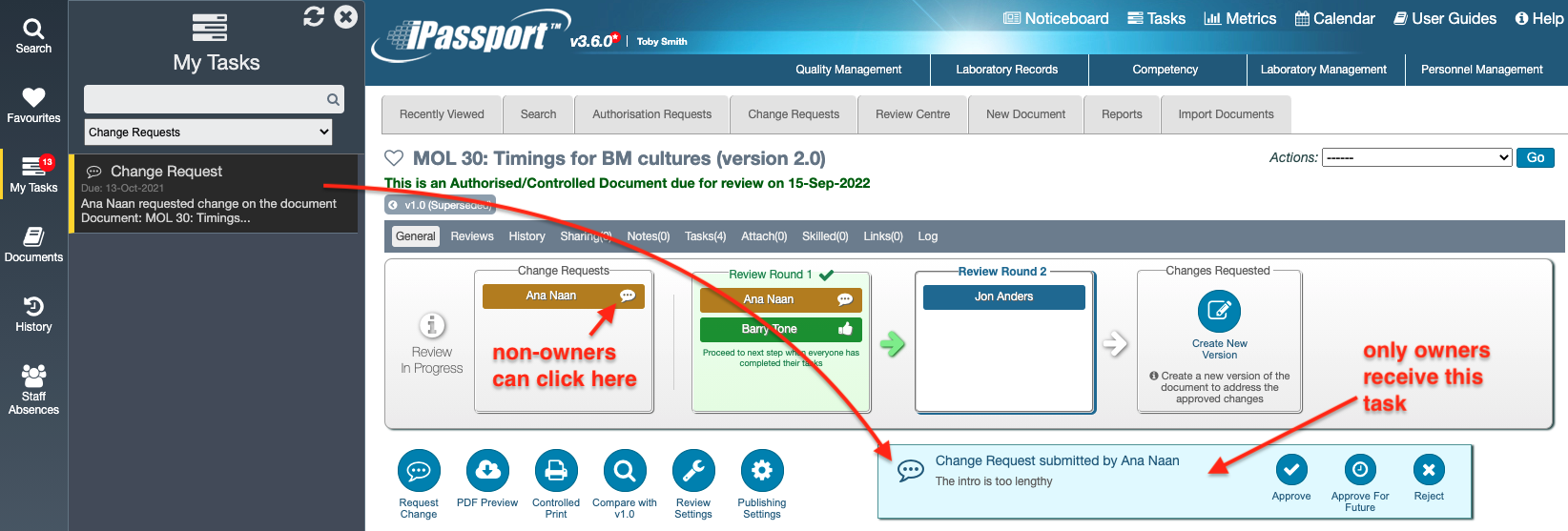
The document owner will be tasked with approving or rejecting the change request. A familiar light blue box will provide the choices the document owner can make - Approve, Approve for Future or Reject.
Users on the notification list won’t receive a task but if they have permission to ‘manage review tasks’ for the document in question, they can click the speech bubbles in the ‘Change Requests’ section to bring up a lightbox with the same options displayed.

All this information is also recorded in the Reviews tab. Change requests can also be approved, rejected or deleted there.
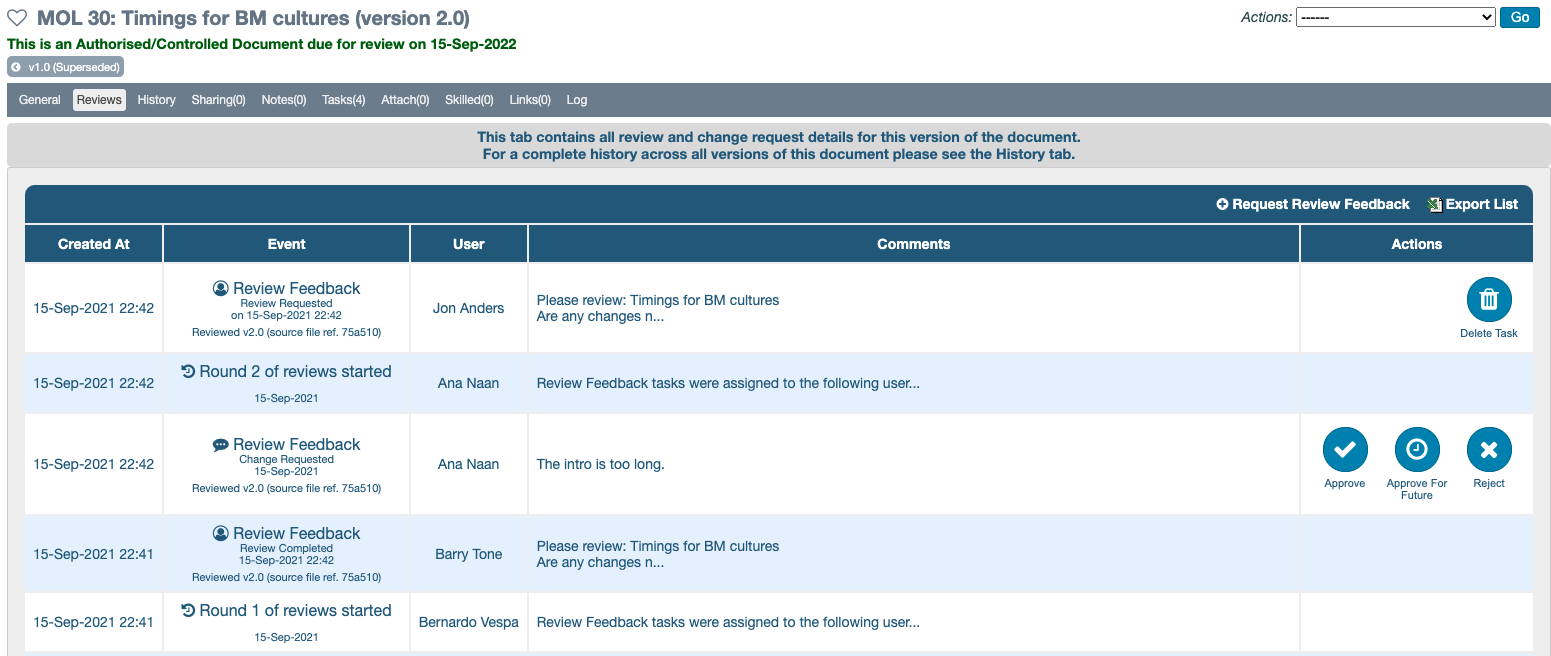
Rejected change requests fall off the list in the workflow’s Change Requests box and get replaced with a legend to notify that change requests have been rejected and can be viewed in the Reviews tab.
Once a change request is approved, the icon next to the name of the person who requested the change will turn into a checkmark icon (✓).
If the verification step is enabled, when a change request is approved, the icon will change into a question mark (?) to indicate verification is still pending. Once verified, a checkmark icon will replace the question mark.
| Change Request awaiting approval (💬) | Change Request awaiting verification (?) | Change Request approved or verified (✓) |
|---|---|---|
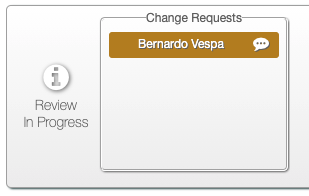 |
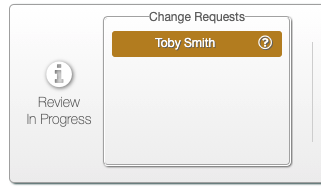 |
 |
If change requests are approved, the system will expect a new version of the document to be created to incorporate the changes. The system will guide the document owners in this direction.
Alternatively, if a change request is valid but not worth including in the current review, it can be marked, Approved for Future. It will not interfere with the current review but it will be present in the next review so it’s not forgotten. More details can be found in the
Document Change Requests user guide.
Deciding When to Create a New Version
If there are multiple review rounds, once one round is completed, the tasks on the next one will turn blue, following the same conventions as in the first round. When any change requests have been approved, the document owner (and users with equivalent permissions) will have two options:
-
It will be possible to create a new version straight away, before other collaborators have completed their review feedback tasks.
If this action is taken, the review workflow will remain in the current version and the review feedback tasks will still point at it (now an under-review version). When the remaining collaborators open their ‘review feedback’ tasks, they will be directed to evaluate the under-review version and not any new drafts.
If the draft version is edited, the button, ‘Restart Review Cycle’ can be used to terminate the workflow in the under-review version and start a new one in the draft version. The review feedback tasks will then point at the new draft. -
A new version can be created after all collaborators have submitted their feedback.
This alternative allows all collaborators to submit their feedback before any changes are made to the document. Though it implies waiting for all collaborators to complete their review feedback tasks, the process might be easier to follow as it will all remain inside the same version.
Once a draft version is created, the ‘Restart Review Cycle’ will be available in the under-review version but it will run and display on the draft version.
The Restart Review Cycle button is only visible in the under-review version.
To restart the review workflow in a draft version, navigate to the under-review version and click the button there.
The system will detect a new version and it will apply the workflow to the draft version.
Details about creating new versions and submitting them for publishing can be found in the user guide, Create, Edit & Publish New Versions Of Documents. For reviews where no changes are required for the document, please read on to see the process through.
Completing a Review Cycle
The review cycle completion box will change its appearance depending on the workflow settings and the outcome of the review rounds. This step is expected to be completed by the document owner, unless it’s set to complete automatically when no changes are requested. If intervention is required, a task isn’t created for this and users on the notification list who have permission to ‘schedule reviews’ for the document in question can also complete it.
The legend in the review cycle completion box will state which choice was made in the workflow design - whether the review cycle should complete automatically if no changes were requested or whether manual intervention should always be required.
If no changes are requested, there are three possible outcomes:
- Automatic completion is set and the rule to calculate the next review date is based on the previous review date.
- Automatic completion is set and the rule to calculate the next review date is locked into a specific time frame.
- Manual completion is set. A ‘Complete Review Cycle’ button becomes available to the document owner and users in the notification list, provided they have permission to ‘schedule reviews’ for the document in question.
As soon as a change request is submitted, the completion box changes to prompt creating a new version of the document. If any change requests are approved (and verified when required), it will remain in the same state, with a ‘Create New Version’ button available to the document owner and users on the notification list, provided they have permissions to ‘Create New Versions’ for the document in question.
If all change requests are rejected, the completion box will revert to one of the first three cases above, according to the workflow settings.
| Automatic Completion - rule based on previous review |
Automatic Completion - rule based on set date |
Intervention Required | New Version Required |
|---|---|---|---|
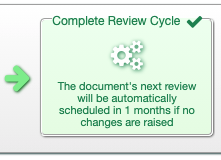 |
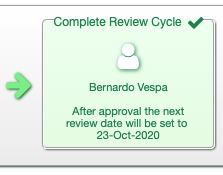 |
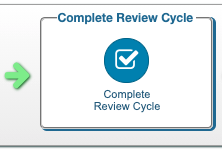 |
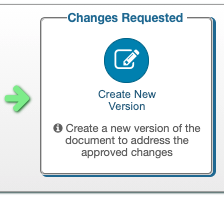 |
Approving a Review Cycle
This step can be considered equivalent to authorising a draft version of a document. In many organisations it’s equally important for the lab director’s name to appear on newly authorised documents, as on documents which were last reviewed without any changes being made to them. This demonstrates compliance with the requirement to review documents periodically.
When an approval step is added, it will only be invalidated if a new version of the document is created or if the approver completes the previous step (Complete Review Cycle). The review approval step does generate a task which can’t be deleted or completed by anyone else (unless the approver is inactivated and tasks are transferred). Approvers can complete their tasks within iPassport or from the email they receive, without having to log into iPassport.
Approving a Review Cycle from the Notification Email
As with all iPassport tasks, emails are generated for the users assigned a ‘review approval’ task. These emails contain a link which when clicked will open another tab in the browser.
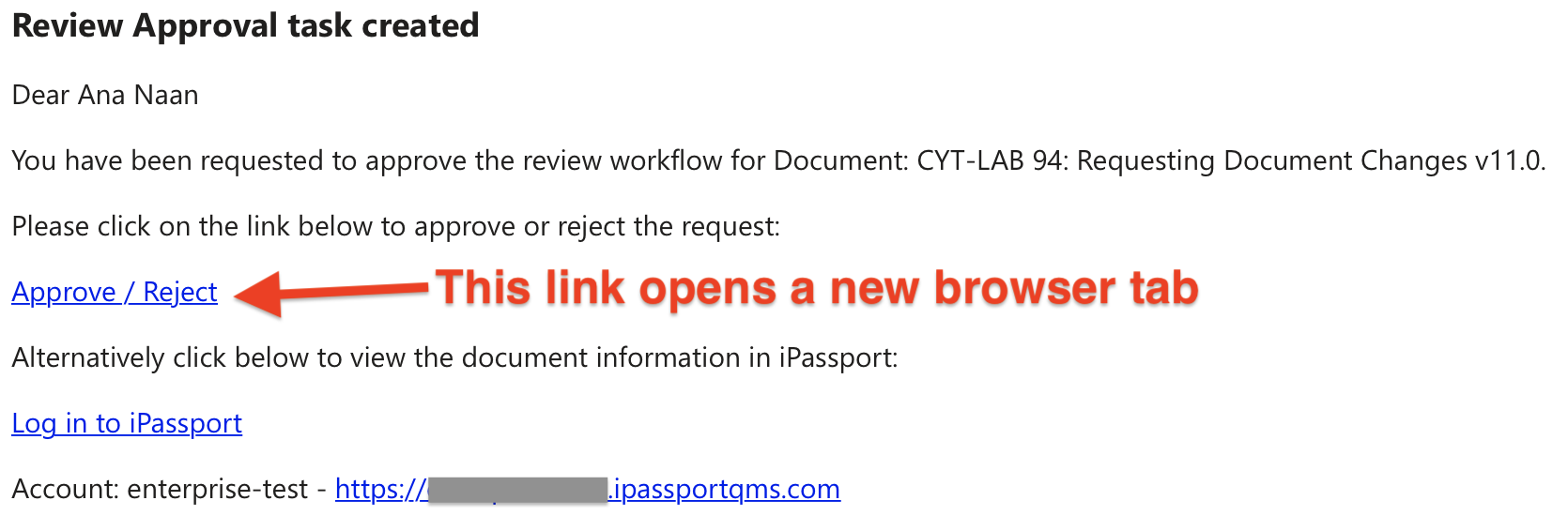
The new window will display a document preview if it’s available (only Word, PDF, RTF files can be previewed) and, there will be buttons at the top to approve or reject the review cycle.
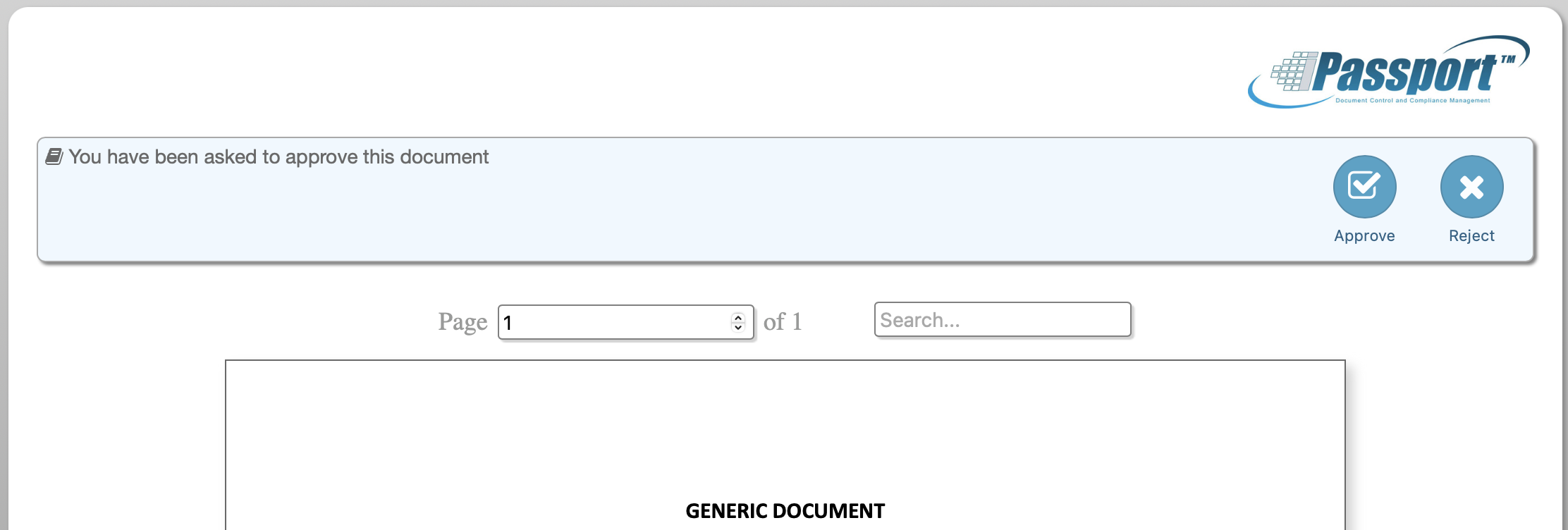
Once the ‘Approve’ button is clicked, the tab will refresh to confirm the operation was successful.
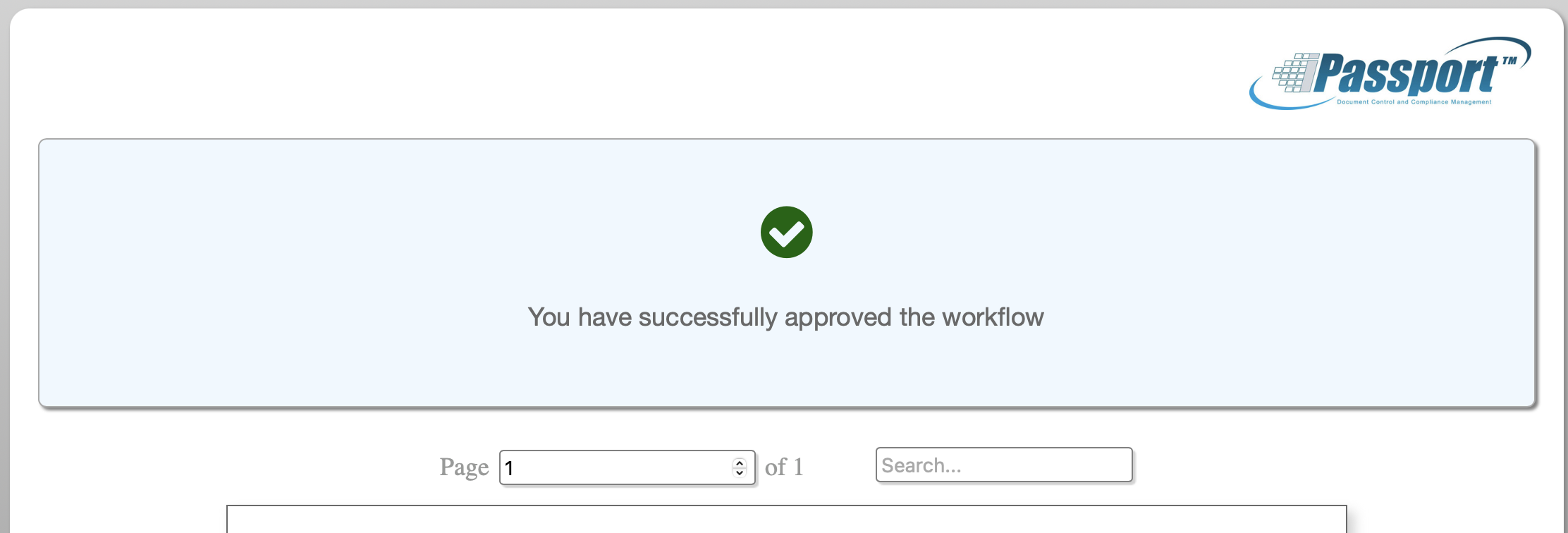
If the ‘approver’ clicks the same link again, the message, “The task has already been completed” will display in the linked browser tab.
If a review approval task is assigned to multiple users but only one is required to complete it, once any of them approves the review, the others will see the message, “Sorry, this link is no longer valid”.
Approving a Review Cycle within iPassport
The approval task will show in the approver’s screen as a light blue box with options to approve or reject the review cycle. If the cycle is being approved, a field will be available to adjust the next review date when necessary.
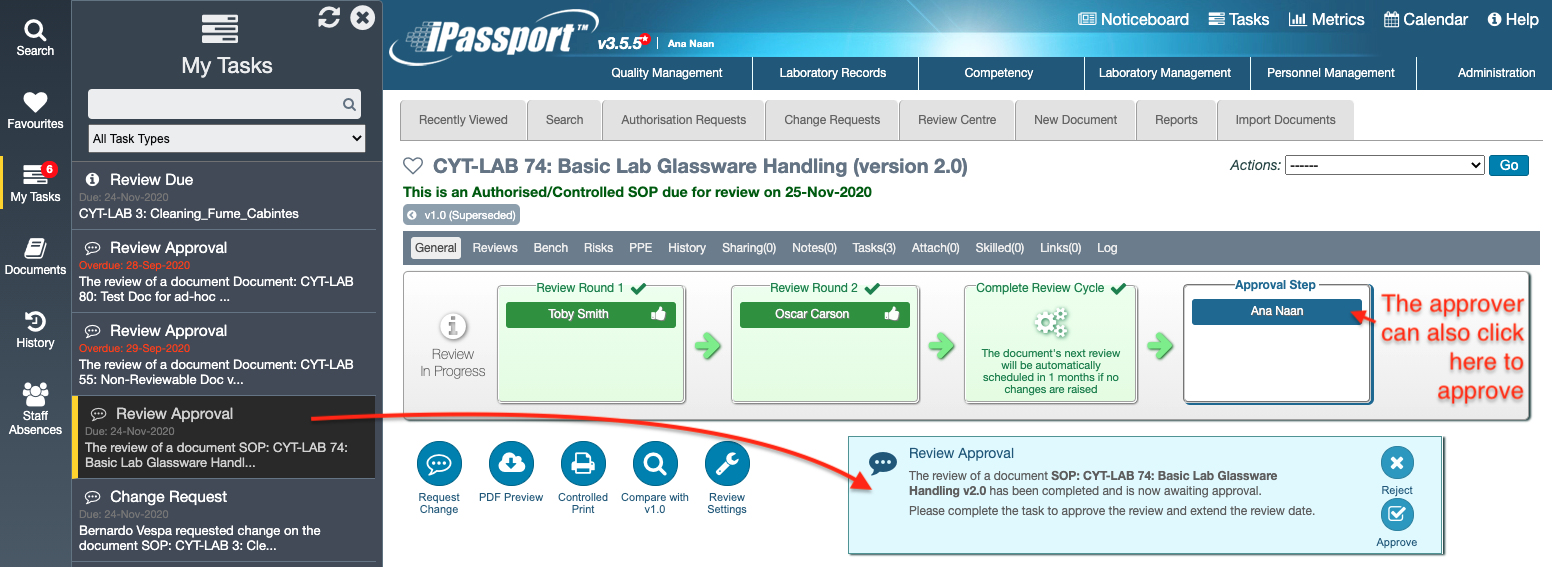
Clicking the blue box with the approver’s name in the workflow will bring up the same approval lightbox.
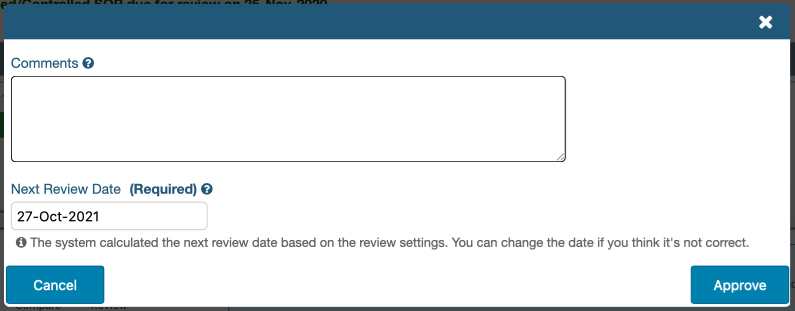
If the approver rejects the review cycle approval, the box with the approver’s name will turn red. At this point, the owner or someone on the notification list can come in and select one of three options from the Actions dropdown menu:
- ‘Create new version’ - a new draft version will be created to update the document
- ‘Review Document’ - the review cycle will be bypassed and a next review date can be set
- ‘Start Review Workflow’ - the review cycle can be started again

Approvers will have an extra tab named, Documents to Approve under their My Tasks tab (reached by navigating to Tasks > My Tasks in the global menu). Here, they can select multiple documents to approve in one step. This is described in the next article, Managing Reviews.
Ad Hoc Change Requests and Review Feedback Requests
Change requests can be raised at any time and they will be added in the Change Requests section of the workflow.
If the command, ‘Request Review Feedback’ is triggered from the Reviews tab, a new section is added on the left of the workflow - Ad Hoc Reviews.
Any change requests submitted after the review rounds have been completed will be reserved for the next review, as if ‘approved for future’.

Monitoring Reviews
Approvers, document owners and other users in charge of maintaining documents have tools available to make their job easier and identify which documents require some action to move them forward in their review workflow. These are described in the next article (Managing Reviews).
NEXT STEP: Managing Reviews
PREVIOUS STEP: Configuring Document Reviews